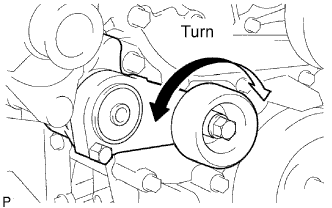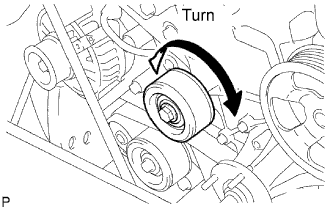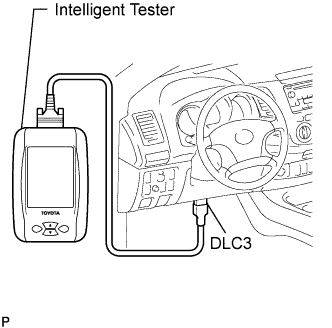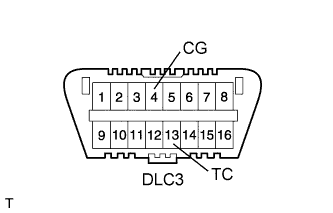Engine -- On-Vehicle Inspection |
| 1. INSPECT AIR CLEANER FILTER ELEMENT |
Remove the air filter.
Visually check that the air filter is not excessively damaged or oily.
If necessary, replace the air filter.
| 2. INSPECT V-RIBBED BELT TENSIONER |
Idle the engine and then stop the engine. Check that the drive belt is within the edges of the tensioner pulley.
 |
Remove the drive belt from the tensioner pulley.
Turn the pulley, and check that the tensioner bearing moves smoothly and quietly.
If necessary, replace the tensioner pulley.
Install the drive belt.
| 3. INSPECT NO. 1 IDLER PULLEY |
Idle the engine and then stop the engine. Check that the drive belt is within the edges of the idler pulley.
 |
Remove the drive belt from the idler pulley.
Turn the pulley, and check that the idler bearing moves smoothly and quietly.
If necessary, replace the idler pulley.
Install the drive belt.
| 4. CHECK VALVE LASH ADJUSTER NOISE |
Rev up the engine several times. Check that the engine does not emit unusual noises.
If unusual noises occur, warm up the engine and idle it for over 30 minutes. Then repeat the step above.
- HINT:
- If any defects or problems are found during the inspection above, perform a lash adjuster inspection (Toyota Fortuner RM0000012NU009X_01_0001.html).
| 5. INSPECT IGNITION TIMING |
Warm up the engine and stop the engine.
- NOTICE:
- A warmed up engine should have an engine coolant temperature of over 80°C (176°F), have an engine oil temperature of 60°C (140°F), and the engine rpm should be stabilized.
When using the intelligent tester:
Check the ignition timing.Connect the intelligent tester to the DLC3.
Start the engine and idle the engine.
Turn the intelligent tester main switch ON.
Enter the following menus: Powertrain / Engine and ECT / Data List / IGN Advance.
- Standard ignition timing:
- 0 to 20° BTDC @ idle
- HINT:
- Please refer to the intelligent tester operator's manual for further details.
 |
When not using the intelligent tester:
Check the ignition timing.Using SST, connect a tachometer tester probe to terminal 9 (TAC) of the DLC3.
- SST
- 09843-18030
- NOTICE:
- Confirm the terminal number before connecting SST. Connection with a wrong terminal can damage the engine.
- Turn off all electrical systems before connecting SST.
Clamp a timing light tester probe to the No. 1 cylinder ignition coil connector's 4 lead wires or green-red lead wire.
Start the engine.
Using SST, connect terminals 13 (TC) and 4 (CG) of the DLC3.
- SST
- 09843-18040
- NOTICE:
- When checking the ignition timing, the transmission should be in the neutral position.
- HINT:

- After connecting terminals TC and CG, the engine rpm changes to approximately 1,000 to 1,500 rpm for 5 seconds, and then returns to idle speed. This occurs because the ECM checks that the ISC (idle speed control system) is operating properly.
- Perform the inspection of the ignition timing after the engine rpm has returned to idle speed.
Using a timing light, measure the ignition timing.
- Standard ignition timing:
- 3 to 7° BTDC @ idle
Remove SST from terminals 13 (TC) and 4 (CG) of the DLC3.
Check the ignition timing.
- Standard ignition timing:
- 0 to 20° BTDC @ idle
Confirm that the ignition timing moves to the advanced angle side when the engine speed is increased.
Remove the timing light.



 |
| 6. INSPECT ENGINE IDLE SPEED |
Warm up and stop the engine.
- NOTICE:
- A warmed up engine should have an engine coolant temperature of over 80°C (176°F), have an engine oil temperature of 60°C (140°F), and the engine rpm should be stabilized.
When using the intelligent tester:
Check the idle speed.Connect the intelligent tester to the DLC3.
- HINT:
- Please refer to the intelligent tester operator's manual for further details.
Start the engine and idle the engine.
Turn the intelligent tester main switch ON.
Enter the following menus: Powertrain / Engine and ECT / Data List / Engine SPD.
- Standard idle speed:
- 600 to 700 rpm
- NOTICE:
- When checking the idle speed, the transmission should be in the neutral position.
- Switch off all accessories and the air conditioning before connecting the intelligent tester.

When not using the intelligent tester:
Check the idle speed.Using SST, connect a tachometer tester probe to terminal 9 (TAC) of the DLC3.
- SST
- 09843-18030
- NOTICE:
- Confirm the terminal number before connecting SST. Connection with a wrong terminal can damage the engine.
- Turn off all electrical systems before connecting SST.
Start the engine and idle the engine.
Check the idle speed.
- Standard idle speed:
- 600 to 700 rpm
 |
| 7. INSPECT IDLE SPEED CONTROL SYSTEM |
Warm up and stop the engine.
- NOTICE:
- A warmed up engine should have an engine coolant temperature of over 80°C (176°F), have an engine oil temperature of 60°C (140°F), and the engine rpm should be stabilized.
Check the idle speed control system.
Start the engine and idle the engine.
Using SST, connect terminals 13 (TC) and 4 (CG) of the DLC3.
- SST
- 09843-18040
- NOTICE:
- Confirm the terminal numbers before connecting them. Connecting the wrong terminals can damage the engine.
- Turn off all electrical systems before connecting the terminals.
- When checking the ISC function, the transmission should be in the neutral position.
After connecting terminals TC and CG, check that the engine speed changes to approximately 1,000 to 1,500 rpm for 5 seconds, and then returns to idle speed.
If the result is not as specified, check the throttle body, DTCs (Toyota Fortuner RM000000ZPR007X.html) and wire harness.

 |
| 8. INSPECT COMPRESSION |
Warm up and stop the engine.
- NOTICE:
- A warmed up engine should have an engine coolant temperature of over 80°C (176°F), have an engine oil temperature of 60°C (140°F), and the engine speed should be stabilized.
Disconnect the injector connectors.
Remove the ignition coils.
Remove the spark plugs.
Check the cylinder compression pressure.
Insert a compression gauge into the spark plug hole.
Fully open the throttle.
While cranking the engine, measure the compression pressure.
- Standard compression pressure:
- 1230 kPa (12.5 kgf/cm2, 178 psi)
- Minimum pressure:
- 880 kPa (9.0 kgf/cm2, 128 psi)
- Difference between each cylinder:
- 68 kPa (0.7 kgf/cm2, 10 psi)
- NOTICE:
- Always use a fully charged battery to obtain an engine speed of 250 rpm or more.
- Check the other cylinders' compression pressure in the same way.
- This measurement must be done as quickly as possible.
- HINT:
- If adding oil increases the compression, the piston rings and/or cylinder bore may be worn or damaged.
- If the pressure stays low, a valve may be stuck or seated improperly, or there may be leakage in the gasket.
 |
| 9. INSPECT CO (for Leaded Gasoline Specification Vehicle) |
- HINT:
- This check is used only to determine whether or not the idle CO complies with regulations.
Initial condition:
Engine at normal operating temperature
Air cleaner installed
All pipes and hoses of air induction system connected
All accessories switched OFF
All vacuum lines properly connected
SFI system wiring connectors fully seated
Ignition timing set correctly
Transmission in neutral position
Tachometer and CO meter calibration at idle
- NOTICE:
- If a CO meter is not available, do not attempt to adjust the idle mixture. Always use a CO meter when adjusting the idle mixture. Use of the idle mixture screw for adjustments is typically not necessary if the vehicle is in good condition.
Warm up the engine at a constant speed (approximately 50 km/h (31 mph)). Close the throttle valve for 5 minutes after the engine coolant temperature becomes stable (80 to 90°C (176 to 194°F)) and idle the engine for 5 minutes.
Insert a tester probe at least 40 cm (1.3 ft.) into the tailpipe.
 |
Wait at least 1 minute before measuring to allow the concentration to stabilize. Complete the measuring within 3 minutes.
- Standard idle CO concentration:
- 0.5 to 2.5%
If the CO concentration does not conform to regulations, adjust it by turning the idle mixture adjusting screw in the variable resistor with SST.
- SST
- 09243-00020
 |
The idle mixture adjusting screw can be adjusted within a 180° angle range.
If the CO concentration is within the specification, this adjustment is complete.
If the CO concentration cannot be corrected by idle mixture adjustment, see the table below for other possible causes.CO Problems Causes High Rough idle
(black smoke from exhaust)- Clogged air filter
- Plugged ventilation valve
- Faulty SFI system
- Faulty fuel pressure regulator
- Clogged fuel pressure regulator
- Defective engine coolant temperature (ECT) sensor
- Faulty ECM
- Faulty injectors
- Faulty throttle position sensor
- Faulty MAF meter
- Clogged air filter
 |
| 10. INSPECT CO/HC (for Unleaded Gasoline Specification Vehicle) |
Start and warm up the engine.
Run the engine at 2,500 rpm for approximately 180 seconds and idle the engine.
Insert a CO/HC meter testing probe at least 40 cm (1.3 ft.) into the tailpipe.
 |
Check the CO/HC concentration at idle.
- Idle CO concentration:
- 0 to 0.5%
- Idle HC concentration:
- Applicable local regulation
If the CO/HC concentration is not as specified, perform troubleshooting in the order given below.
Check the heated oxygen sensor operation (Toyota Fortuner RM000000ZQ9007X.html).
See the table below for possible causes, and then inspect and repair the applicable causes as necessary.
CO HC Problems Causes Normal High Rough idle - Faulty ignitions:
- Incorrect timing
- Plugs are contaminated, shorted or gaps are defective
- Incorrect valve clearance
- Leaks in intake and exhaust valves
- Leaks in cylinders
Low High Rough idle
(Fluctuating HC reading)- Vacuum leaks:
- Ventilation hoses
- Intake manifold
- Throttle body
- Brake booster line
- Lean mixture causing misfire
High High Rough idle
(Black smoke from exhaust)- Restricted air filter
- Plugged ventilation valve
- Faulty SFI system:
- Faulty pressure regulator
- Defective ECT sensor
- Defective Mass Air Flow (MAF) meter
- Faulty ECM
- Faulty injectors
- Faulty throttle position sensor
- Faulty ignitions: